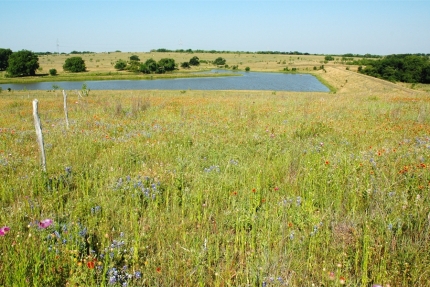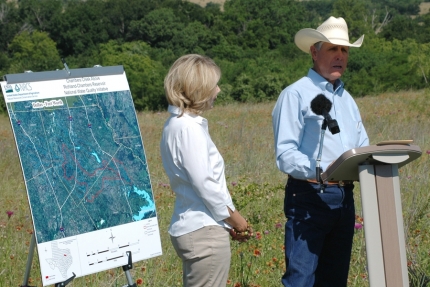Related Rural Blog Posts
Making Broadband Construction Faster and Cheaper
Posted by on June 13, 2012 at 6:26 PM EDTTomorrow, the President will sign an Executive Order to make broadband construction along Federal roadways and properties up to 90 percent cheaper and more efficient. Currently, the procedures for approving broadband infrastructure projects on properties controlled or managed by the Federal Government—including large tracts of land, roadways, and more than 10,000 buildings across the Nation—vary depending on which agency manages the property. The new Executive Order will ensure that agencies charged with managing Federal properties and roads take specific steps to adopt a uniform approach for allowing broadband carriers to build networks on those assets. It will also allow service providers to deploy broadband while roads are under construction, a practice that hugely cuts costs.
Additionally, at an event beginning at 9am ET tomorrow, the White House will announce that nearly 100 partners—including cities, national research institutions, and industry supporters—have formed a new public-private partnership called “US Ignite.” The US Ignite Partnership will create a new wave of services that take advantage of state-of-the-art broadband networks running up to 100 times faster than today’s Internet. By bringing together government agencies, private companies, and communities, the partnership aims to accelerate the development of applications for advanced manufacturing, medical monitoring, emergency preparedness, and a host of other services. These applications will improve services to Americans, drive job creation, promote innovation, and create new markets for American businesses.
The President’s Executive Order and the US Ignite partnership are a two-pronged approach to help speed the delivery of connectivity to communities, businesses, and schools across the Nation. “By connecting every corner of our country to the digital age,” President Obama said. “We can help our businesses become more competitive, our students become more informed, and our citizens become more engaged."
Learn more about US Ignite’s current projects in Cleveland, OH, Chattanooga, TN, and Clemson/Portland.
For a complete list of US Ignite’s partners and initiatives across the country, check out their interactive map.
Learn more:
Read about additional actions President Obama has taken to support middle class Americans
Learn more about Rural, TechnologyKey Federal Agencies Collaborate to Provide Funding and Support for Rural America
Posted by on June 13, 2012 at 5:09 PM EDTOn Tuesday, June 12, three federal agencies announced a new project to assist high-need rural areas facing chronic poverty along the U.S.-Mexico border. This new project is part of a series of initiatives delivered through the White House Rural Council, which recently released a report detailing the steps President Obama and this administration have taken to support rural America.
The Border Community Capital Initiative (“Border Initiative”) is a collaborative effort among the Department of Agriculture-Rural Development (USDA-RA), Department of Treasury’s Community Development Financial Institutions (CDFI), and the Department of Housing and Urban Development (HUD). These three federal agencies signed a Memorandum of Understanding (MOU) and, together, will increase economic development activity at a community level throughout these high need areas, known as colonias.
Colonias are communities within 150 miles of the U.S.-Mexico border. These high-need communities frequently lack fundamental resources such as sanitary housing, access to potable water, and adequate sewage systems. Under the Border Initiative, up to $200,000 will be made available to nonprofit and tribal financial institutions serving colonias. These funds will be used for direct investment and technical assistance focused on providing access to valuable resources that these communities lack.
Previous federal programs with similar goals have faced significant barriers in implementation, such as limited capacity among organizations serving colonias and a lack of stable funding available to them. The Border Initiative is tailored to correct for this by directing funds toward improving the capacity of local financial institutions to raise capital and increase lending; and boosting investment in their communities.
Learn more about RuralConnecting Educators, Building Communities Across Rural America
Posted by on June 13, 2012 at 2:49 PM EDTEd. Note: This is cross-posted from the ED Blog
In an increasingly interconnected world, we can no longer allow geography to be a barrier to education and opportunity in rural America.
Through the national broadband plan and unprecedented investments in education reform, the Obama administration is leveraging the power of technology to overcome distance and increase collaboration to accelerate student achievement in rural schools.
Today, the White House Rural Council announced the U.S. Department of Education's new online community of practice group for rural schools. Virtual communities of practice provide a platform for educators to connect to resources, tools, colleagues, experts, and learning activities, both within and beyond schools.
Learn more about RuralWhite House Rural Council Celebrates Its One Year Anniversary
Posted by on June 11, 2012 at 6:47 PM EDTToday, President Obama talked to local TV reporters from communities around the country with significant rural populations. These interviews come as the White House released a report noting progress that has been made in the agricultural economy and detailing the steps the Obama Administration has taken to help strengthen the farm economy and support jobs in rural America. The report was developed by the White House Rural Council, the Council of Economic Advisors, and the U.S. Department of Agriculture. In addition, the President announced new investments to help rural small businesses expand and hire.
One year ago today, President Obama established the White House Rural Council in order to better coordinate federal programs and maximize the impact of Federal investment to promote economic prosperity and improve the quality of life in rural communities. It truly is exciting that in just one year, more than a dozen new policy initiatives have been launched to assist rural America. One of those initiatives was a new commitment to invest in rural businesses through the Small Business Administration’s Small Business Investment Company (SBIC) program, at no cost to tax payers. Today the President announced that more than $400 million has already been invested this fiscal year in these businesses through the SBIC program, and that nearly $2 billion in additional funding will be invested by the end of fiscal year 2016.
Innovative Financing: Creating Access and Opportunity For Small Business In America's Rural Economy
Posted by on June 11, 2012 at 11:53 AM EDTEd. Note: This is cross-posted from the SBA Blog
This week marks the one-year anniversary of the creation of the White House Rural Council, an Administration-wide initiative to support and strengthen America’s rural economy. And our progress over the last year is detailed in a new report released today.
As part of our efforts, we are making sure that more entrepreneurs who live in rural areas have the access and opportunity they need to start, build and grow their businesses.
We know innovation and entrepreneurship doesn’t just take place in New York and Silicon Valley. It’s happening in West Virginia, all along the I-79 High Tech Corridor, where I was last month. It’s happening in Iowa and Georgia and Nebraska.
And if we want to continue to grow our economy—and be more globally competitive—we need to make sure that we can harness the potential of entrepreneurs and small businesses in all of these communities.
To make that possible, the Small Businesses Administration is working to increase the flow of capital to rural areas. In fact, SBA has helped put more than $400 million in investment capital directly into the hands of high growth rural businesses through our agency’s Small Business Investment Companies (SBICs) since last October.
Learn more about RuralA Clear Answer to Clean Water
Posted by on June 7, 2012 at 3:48 PM EDTHow important is water? Well, it’s not a question I have to think too hard about. What I can tell you is that without it, there wouldn’t be any humans or critters roaming the earth.
In the U.S., we use a little more than 400 billion gallons of water a day. According to the UN, in the worldwide picture about one in five people lack access to a clean, improved water source.
At USDA’s Natural Resources Conservation Service (NRCS) we view clean water as a top priority. Every day, our employees work with farmers and ranchers to improve on-farm water management—using a systems approach to avoid, control and trap pollutants.
The type of pollutants we are working to control, through our conservation actions or “practices” are farm waste, fertilizer, sediments, pesticides and herbicides. Our goal is to stop these at or before the edge of a field, so they don’t run into the water. And that’s why we recently created the National Water Quality Initiative.
Through this effort we are focusing on priority watersheds in every state, where on-farm conservation investments have the best chance to improve water quality. To do this, we took an in-depth look at the impaired waterways list and then we asked for input from our local and state partners to pick the watersheds that were ultimately selected as a focal area.
We launched the National Water Quality Initiative with $33 million dedicated for farmers and ranchers, with financial assistance for any size agriculture operation to help reduce the loss of excess nutrients and sediments from their fields. We expect to show how the actions of farmers and ranchers can remove a stream from the impaired list.
When large numbers of farmers take action together in one area, in one watershed, it can make a difference—it can stop an algae bloom or keep bacteria from reaching a drinking water source. And clean water is absolutely critical for the freshwater ecosystems that 44,000 aquatic species call home.
In Texas, ranchers Gary and Sue Price have been working with NRCS and the Navarro Soil and Water Conservation District for over 35 years to implement conservation practices on their ranch which lies in the Trinity River Basin—an area that provides water for over 40 percent of Texans.
The Prices began addressing water quality several years ago when they converted a portion of their cropland to a wetland. Wetlands are the clean water sponges, or kidneys, of the land. They minimize soil erosion and are excellent wildlife habitat. The couple also installed a riparian buffer with native plants. This buffer acts as a filter while creating habitat for both bobwhite quail and Rio Grande turkey.
If you are a farmer, rancher or forest landowner interested in signing up, you can check a map online and see if you are located in a priority area. If you prefer the in-person route, we have USDA service centers in almost every county, and you are always welcome to stop in and complete an application. Applications must be submitted by June 15, 2012 in order to be considered for this fiscal year’s funding opportunity.
Since the White House Rural Council was established last June, the Council has provided a forum for increasing conservation work and creating jobs in rural America. Through the National Water Quality Initiative, we will have measurable progress achieved with support from the Rural Council.
Follow NRCS on Twitter.
Dave White is Chief of the Natural Resources Conservation Service (NRCS)
Learn more about Energy and Environment, Rural
- &lsaquo previous
- …
- 7
- 8
- 9
- 10
- 11
- 12
- 13
- 14
- 15
- …
- next &rsaquo



